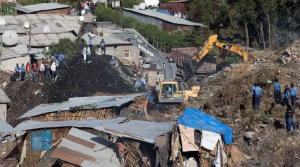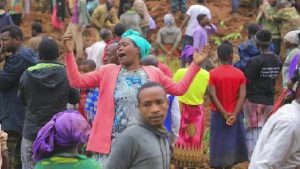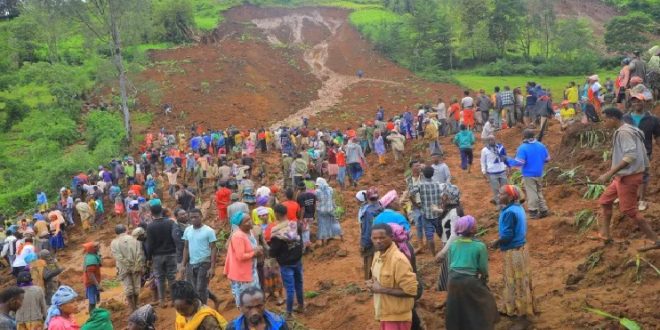24-07-2024
ADDIS ABABA: The number of people killed in landslides in southern Ethiopia has risen to at least 146, local officials have said.
Two incidents are thought to have occurred on Sunday evening and Monday morning, after heavy rains in a remote mountainous area of the Gofa zone.
 The local authority said the search for survivors was “continuing vigorously” but that the “death toll could yet increase”.
The local authority said the search for survivors was “continuing vigorously” but that the “death toll could yet increase”.
Footage showed hundreds of people gathered at the scene and others digging in the dirt in search of people trapped underneath.
In the background, a hillside can be seen partially collapsed and a large patch of red earth has been exposed.
Meskir Mitku, the general administrator of the Gofa zone, said women, children, and police officers were among the casualties.
“There was a heavy rain yesterday (Sunday) night and some people died from a landslide,” government spokesperson for the Gofa district Kassahun Abayneh said.
“In the morning [Monday], locals, including police, gathered at the site to save those who were affected by the first landslide. That is when the second landslide happened around 10:00 [07:00 GMT] today and those who gathered there died,” he said in quotes cited by AFP news agency.
Gofa is part of the state known as Southern Ethiopia, located around 320km (199 miles) south-west of the capital, Addis Ababa.
A statement by Gofa zone’s communication department said the death toll had passed 146, and could rise further, media reports.
Southern Ethiopia is among the areas of the country that have been hit by particularly heavy rain and flooding in recent months, according to the UN’s Office for the Coordination of Humanitarian Affairs (Ocha) but instances of landslides and floods go back further. In May 2016, at least 50 people were killed in floods and landslides following heavy rain across the south of the country.
 Many factors contribute to flooding, but a warming atmosphere caused by climate change makes extreme rainfall more likely.
Many factors contribute to flooding, but a warming atmosphere caused by climate change makes extreme rainfall more likely.
The world has already warmed by about 1.2C since the industrial era began and temperatures will keep rising unless governments around the world make steep cuts to emissions.
At least 50 people in Ethiopia had died in floods and landslides caused by heavy rain in 2016 while hundreds have been killed in different incidents linked to climate change in many parts of the country during last ten years.
The rainfall follows one of the worst droughts in more than 50 years, made worse by the El Nino phenomenon.
Administrators in the southern district of Wolaita said 41 people had died in landslides on Monday.
Nine other people drowned in floods in the south-eastern area of Bale that also killed hundreds of head of cattle.
The flooding in Bale, in the south of the Oromia region, has reportedly affected 559 hectares (1,381 acres) of farmland too, washing away seeds.
Rescue efforts are under way to save people missing in the landslides, Wolaita police commissioner Alemayehu Mamo told Fana Broadcasting Corporate (FBC), external but a major road and bridge had also been damaged in the SNNP region, hampering rescue efforts, he said.
More than 10 million people are already in need of urgent humanitarian assistance because of the drought the government and aid agencies have launched a $1.4bn (£970m) appeal to help those requiring urgent food assistance. (Int’l News Desk)
 Pressmediaofindia
Pressmediaofindia




